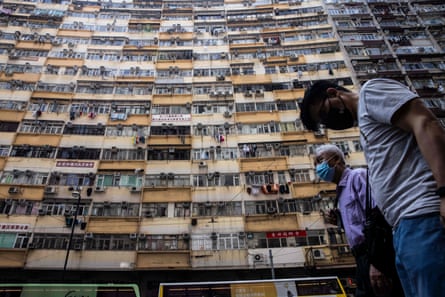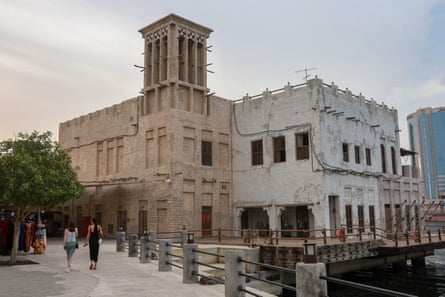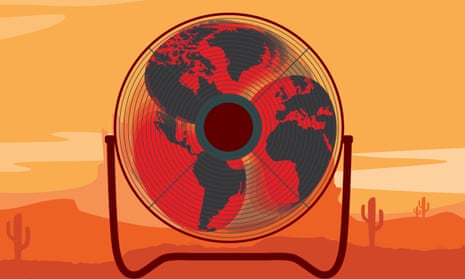“I can honestly say it’s the best thing I’ve ever spent my money on,” says 30-year-old Stephen about the unassuming waist-high plastic pillar that sits in the bedroom of his converted bungalow in Nottinghamshire. The retail worker has always found the room uncomfortably hot in summer, and his attempts to cool down using freestanding fans, electric air coolers and reading up on rudimentary fluid dynamics never seemed to cut it.
When peak temperatures began creeping towards the 40C (104F) mark a few years ago, he splashed out on a portable air conditioner and has never looked back. “If it were to break, I would immediately buy another without a second thought,” he says. “I don’t think I could cope without it in summer now.”
He won’t be the last to feel that way. Less than 5% of British homes were estimated to have air conditioning in 2021, with many of us relying on electric fans to make it through unusually sweaty days and sleepless nights. But as the planet’s global temperature continues to speed towards 1.5C warming, record-breaking heatwaves such as the one that pushed temperatures above 40C last year in the UK will become all the more regular. And with it, our demand to keep cool.
A study led by scientists at Oxford University’s Future of Cooling research programme warned last month that the UK will face a 30% jump in the number of uncomfortably hot days if the global temperature rise reaches 2C. While traditionally hot countries will experience the highest total need for cooling, the UK, Switzerland and Norway will suffer the most dramatic relative increase.
“When we talk about extreme temperatures, African countries are rightfully named as the most affected,” says Nicole Miranda, senior researcher on the Future of Cooling programme and joint first author of the study. “But this is the first study of its nature to show that northern countries are also going to be affected by heat.”
Yet British infrastructure and homes are almost uniquely unprepared. “The UK has some of the poorest housing stock in Europe when it comes to energy efficiency, largely due to poor levels of insulation,” says Abigail Ward, policy and communication officer at the Energy Saving Trust, an independent organisation working to address the climate crisis. She adds that British homes in winter lose heat on average three times faster than European houses. “Because home insulation works in a similar way to a thermal flask – keeping heat out in the summer and in during winter – the lack of sufficient insulation means UK homes are also ill-equipped to stay cool in hotter temperatures.”

For people such as Stephen who are already suffering from the discomfort of their warm homes, a portable air con unit that requires little in the way of installation can seem like an easy fix. But with much of the UK’s electricity still produced through burning fossil fuels, they do little more than cool our homes at the cost of warming our planet.
The Energy Saving Trust estimates an average portable air con unit used for eight hours a day during summer will produce about 140kg of CO2, the same as a seat on a flight from Belfast to Paris and 14 times that emitted by an average electric fan for the same duration. And as Miranda points out, the vicious cycle between air conditioning and greenhouse gases is already in motion, with National Grid resorting to firing up coal-fired power stations in June to meet the extra electricity demand from air con units.
Worse, they tend to leak highly polluting refrigerants – chemicals that are vital to their function but also double as particularly potent greenhouse gases. R-410A, one of the more common refrigerants used in commercial and retail air conditioners, has more than 2,000 times the global heating potential of carbon dioxide. While international agreements have gone some way to reduce their prevalence, they’re still common, and researchers hope those seeking to cool down during extreme temperatures will find other, more climate-friendly solutions.
A passive approach
Ollie Jay, a professor of heat and health at the University of Sydney, has spent years studying low-resource cooling strategies. By placing participants in climate chambers – sealed rooms where the environmental parameters can be precisely controlled – and monitoring their core temperatures under heatwave-simulating conditions, he has found that many of the most effective solutions are those that cool the individual rather than the surrounding air. Handily, they also don’t suck up great amounts of electricity.
Immersing your feet in cold water can reduce heat strain in both hot and humid conditions, while wearing wet clothing that’s resoaked every hour encourages cooling through evaporation. Drinking cold water is a less cumbersome and more direct way to provide internal cooling, and dousing yourself with water using a wet sponge or spray bottle, before allowing the water to evaporate from the skin, is one of the most effective, albeit less commonly advocated, solutions. Though many of these strategies will seem rudimentary and obvious to some, Jay suggests it pays to be judicious.
“So much of what people are advised, even by public health agencies, is informed by conventional wisdom and old wives’ tales,” he says. “It’s essential that we ensure that the actions we are advising people to take have a scientific basis, that they are actually effective at reducing the physiological heat strain that develops when exposed to the heat, because this is what is ultimately dangerous.”
Circulating air using an electric fan, for instance, is a simple way of accelerating the rate at which sweat evaporates from your skin. But try directing one at yourself in temperatures above 42C and you’ll find you quickly overheat. When the air temperature vastly exceeds that of your skin, electric fans do little more than replicate a convection oven: circulating hot air that your body will absorb faster than if you were sitting in a still room. It’s uncomfortable and makes any evaporative benefits obsolete.

“The other thing worth considering is that strategies that make you feel cool may not actually be effectively reducing the internal physiological heat strain all that much,” says Jay. “Thermal sensation is influenced by thermoreceptors on the skin and it’s possible to cool the skin without it necessarily having all that much influence on the deeper tissues of the body.”
Thirst is a typical case. The sensation usually develops well after the body starts to become dehydrated, so relying solely on your own physiological signals to remind you when to drink during a heatwave often isn’t enough. “How we feel, while of course important, isn’t necessarily the most reliable indicator of how much strain the body is under when exposed to heat,” Jay says.
One of the great challenges of cooling is not only reactively responding to oppressive temperatures but adequately preparing for them. Much of this is done through the design of homes to promote passive cooling. Houses in the Middle East have long been constructed with built-in towers called windcatchers that capture cool air and recirculate it throughout the home, and light-coloured paint has proved effective for reflecting heat from the roofs of houses in Pakistan. In the UK, less architecturally involved add-ons can be easily retrofitted to the abundance of older homes that were built to withstand our traditionally colder climate.
Shading is essential. Closing blinds and shutters, opening awnings and hanging blackout curtains on the sun-facing side of your home can block its heating effects. Although basic, it’s effective, and researchers in Spain have found external window shutters can reduce the energy required (such as for air cons or electric fans) to keep people comfortable by up to 14%. For those with gardens, vegetation offers a passive cooling solution. In summer, tall deciduous trees and window shrubs provide essential shade, before shedding their leaves in the colder months to allow the sun to pass through and reach interiors.

Ventilation is also important. Opening windows in the evening allows cooler air to enter and warm air to escape. It’s most effective when cross ventilation can be achieved, whereby cool air moves through an area from one side to the other, maximising circulation.
“We’ve had cheap fossil fuels for so long, and not that many extreme temperatures, we’ve forgotten how to do a lot of the really basic stuff,” says Aaron Gillich, a professor of building decarbonisation at London South Bank University. “Every single home in the country needs to think about them, and there will be a surprising number of fixes that are really achievable at reasonable cost.”
Part of the solution
Since its invention in the early 20th century, modern air conditioning has had a transformative effect on much of the world. No longer restricted by the natural heating cycle of the sun, those in hot climates have been free to work and play in otherwise oppressive temperatures. China’s industrialisation is all but reliant on it, with the country accounting for about one-third of the world’s installed air cons. Singapore’s founding prime minister, Lee Kuan Yew, called it “perhaps one of the signal inventions of history” and attributed the success of his country to its innovation.
Although air conditioning’s impact on the UK has been more muted, Miranda points out that it continues to provide essential comfort to the elderly, infants and other vulnerable members of society. That’s unlikely to change, she says, but it’s important to recognise the technology’s value while also prioritising proper ventilation, insulation, light levels, and seasonal demands in the construction and design of new buildings. “There’s so many passive measures that can be implemented that will save our energy bills and save emissions,” she says. “So air conditioning can be part of the solution, but not the go-to.”
Yet even the most tried-and-tested passive cooling techniques may prove insufficient amid changing climate conditions. Shaded indoor environments are enough to get us through hot days only so long as we can properly cool off when the sun goes down, and ventilation systems similarly require the outside air temperature to drop before it can be invited in. But as heatwaves last longer and temperatures stay high well into the night, the climate patterns on which these centuries-old cooling practices rely are already beginning to break down.
“We will hit a wall sometime in the next decade or two where the past techniques are just not fit for purpose any more,” says Gillich. “A lot of buildings are just going to need air conditioning no matter what, or they will be completely unlivable.”
The white plastic box in Stephen’s bedroom, then, may become a familiar sight in all our homes. The question remains just how much we’ll rely on it.

Comments (…)
Sign in or create your Guardian account to join the discussion